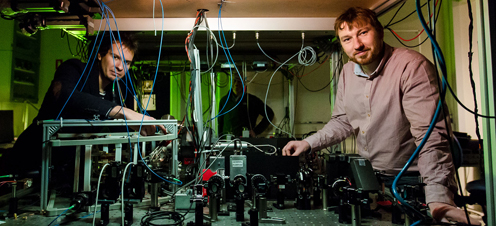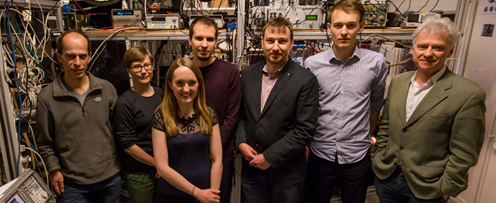Effective reflection of light for quantum technology
Light usually spreads out in all directions and when the light hits an object, it is reflected and is scattered even more. So light is normally quite uncontrollable. But researchers want to be able to control light all the way down to the atomic level in order to develop future quantum technologies. Researchers at the Niels Bohr Institute have therefore developed a new method where they create a very strong interaction between light and atoms, which means that the light can be controlled and reflected on a glass fiber. The results are published in the scientific journal, Physical Review Letters.

Ved at kontrollere afstanden mellem bare 1000 atomer langs en ultratynd glasfibertråd er det lykkedes forskere på Niels Bohr Institutet at opnå en spejleffekt, hvor mere end 10 procent af lyset reflekteres og sendes bagud. Det er et skridt på vejen til at kontrollere lys til fremtidens kvanteteknologi. Eksperimenterne er udført i forskningsgruppens kvanteoptiske laboratorier på Niels Bohr Institutet i København. På billedet ses forskerne Jean Baptiste Béguin og Jürgen Appel.
The experiments are carried out in a glass chamber with an ultra thin optical glass fiber stretched across it. The optical glass fiber has a diameter of 500 nanometers – that is 1000 times smaller than the diameter of a strand of hair. In the glass chamber there is also a gas of caesium atoms, which is cooled down to 50 micro-degrees Kelvin, which is almost absolute zero at minus 273 degrees Celsius. Due to the ultracold temperature, the caesium atoms are almost motionless and they are held close to the surface of the glass fiber. Using laser light, the researchers can push the individual atoms a bit so that they are evenly spaced along the surface of the glass fiber.

Ved hjælp af laserlys har fysikerne arrangeret atomerne langs glasfibertråden med afstande, som præcist passer med bølgelængden på det lys, der sendes gennem glasfiberen. Med kun 1000 atomer har de derved opnået en spejl-effekt, som reflekterer og sender mere end 10 procent af lyset bagud.
Mirror effect
“We now send laser light through the glass fiber. The light has a particular wavelength and when the fiber is thinner than the wavelength of the light, the light moves along the surface of the fiber, where the atoms sit in a row. When the light hits the first atom, a strong interaction is created between the light and the atom and the atom moves with the light wave. With the atom’s precise distance, which matches the wavelength of the light, you get a backwards reflection of the light,” explains Jürgen Appel, associate professor in the research group Quantop at the Niels Bohr Institute at the University of Copenhagen.
He explains that it is this backward reflection that is so important. When the light hits the next atom in the row the same thing happens – and the next, and the next. For every time the light hits an atom, a small part of the light is reflected and sent backwards.
“We have managed to divert more than 10 percent of the light. With only 1000 atoms, an interaction is created that is just as strong as a glass plate with billions of atoms. We have created a mirror that effectively reflects light and we can even turn it on and off,” says Jürgen Appel.
Such an on/off mirror based on just a few atoms can be used to improve the interaction between individual atoms and the fiber-guided light and it can be developed to improve entangled quantum states in connection with captured atomic systems for future quantum technology.

Forskere fra forskningsgruppen Quantop, som har bidraget til forskningen: Jörg Müller, Heidi Lundgaard Sørensen, Christine Pepke Pedersen, Jean-Baptiste Béguin, Jürgen Appel, Kilian Kluge, Eugene Polzik.
The article in Physical Review Letters >>

Jürgen Appel, Associate professor, Quantop research group at the Niels Bohr Institute, University of Copenhagen, +45 3532-5300, +45 3532-5386 (lab.), jappel@nbi.dk
Jörg Müller, Associate professor, Quantop research group at the Niels Bohr Institute, University of Copenhagen, +45 3532-5304, +45 3532-5410 (lab), muller@nbi.dk
Jean Baptiste Béguin, Postdoc, Quantop research group at the Niels Bohr Institute, University of Copenhagen, +45 3533-4116, +45 3532-5386 (lab.), jbeguin@nbi.dk
Eugene Polzik, Professor, head of Quantop research group at the Niels Bohr Institute, University of Copenhagen, +45 3532-5424, polzik@nbi.dk
